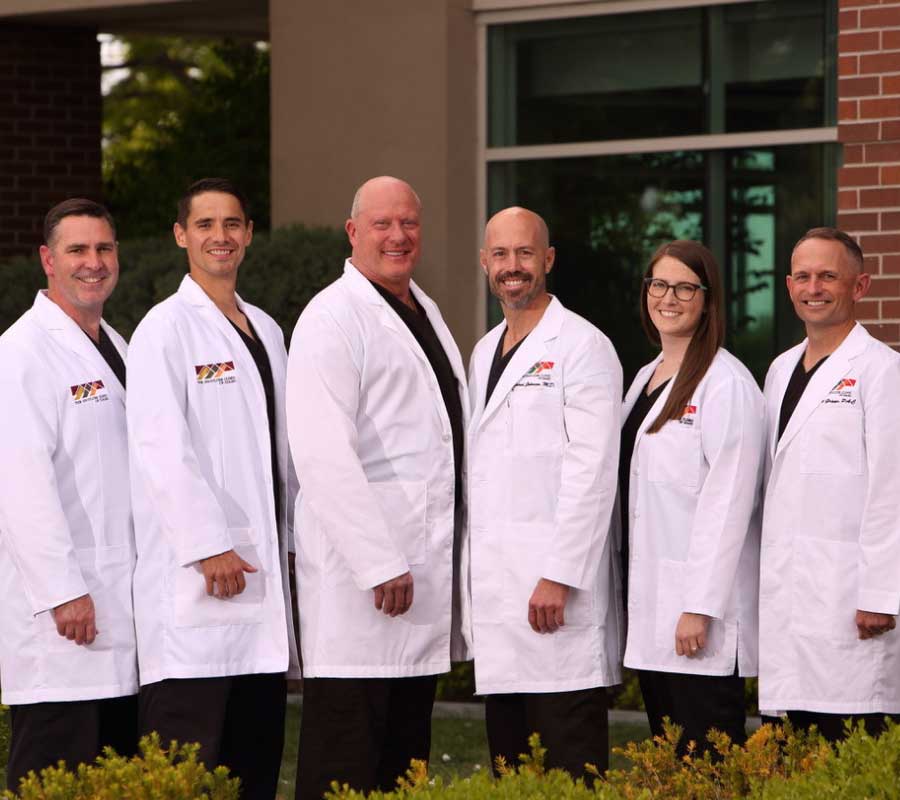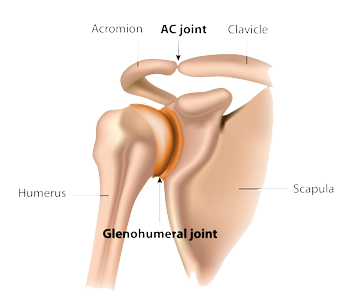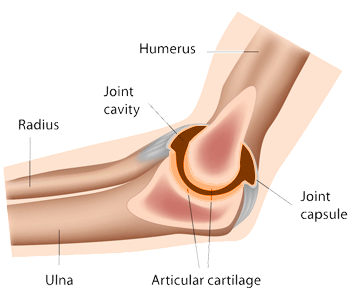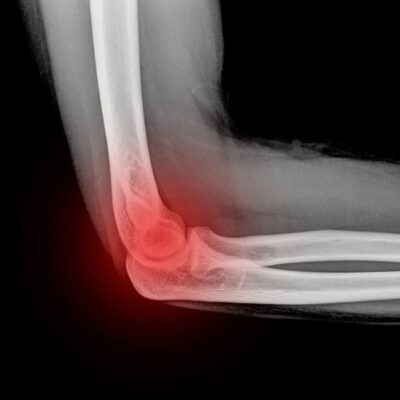Elbow Arthritis Specialists

Are you experiencing mild to severe elbow pain that typically worsens with activity? If so, you may have elbow arthritis. Arthritis of the shoulder is typically found in middle-aged adults and the older population due to the natural aging process. The elbow arthritis specialists at the Shoulder Clinic of Idaho provide diagnosis and both surgical and nonsurgical treatment options for patients in Boise who have developed elbow arthritis. Contact the Shoulder Clinic of Idaho team today!
What is arthritis of the elbow?
Arthritis is a general term, referring to joint inflammation. Any joint in the body is susceptible to arthritis which causes pain, stiffness and swelling. Arthritis of the elbow is typically caused by the cartilage surface becoming damaged or worn. Similar to arthritis involving other joints of the body, arthritis of the elbow can be the result of a degenerative disease, aging, general wear and tear, trauma or a prior elbow injury. Inflammatory and autoimmune conditions may also cause elbow arthritis. The orthopedic specialists at The Shoulder Clinic of Idaho have been helping patients in Boise, Meridian, Nampa, and the surrounding communities of the Treasure Valley who suffer with the painful condition of arthritis of the elbow.
Are there different types of elbow arthritis?
There are several different types of arthritis of the and most manifest clinically with symptoms of pain, stiffness and swelling in the elbow. These include:
- Rheumatoid Arthritis (RA) – The most common cause of arthritis of the elbow, rheumatoid arthritis is an inflammatory disease of synovial tissue – the joint lining which produces synovial fluid. Synovial fluid fills the elbow joint and reduces friction between the gliding cartilage surfaces covering the ends of the bones. In rheumatoid arthritis the synovial lining swells, the joint space narrows, and the cartilage and bones begin to erode. Rheumatoid arthritis gradually destroys the bones and soft tissues. Patients who suffer from rheumatoid arthritis typically will have other joints which are affected by this disease.
- Osteoarthritis (OA) – Is the most common form of arthritis in general, and the second most common cause of elbow arthritis. In the elbow it is a chronic condition characterized by the breakdown of cartilage that cushions the end of the bone where the joint forms. This breakdown leads to “bone-on-bone” movement, which causes pain, stiffness and loss of joint movement. Unlike rheumatoid arthritis which is characterized by joint erosions, osteoarthritis is characterized by bone spurs (osteophytes) and loose bodies.
- Juvenile Arthritis (JA) – Juvenile arthritis is the term used to describe any type of arthritis that begins before the age of 16. Characterized by pain, swelling and joint destruction, the oligoarticular form (meaning less than 5 involved joints) of juvenile arthritis commonly affects elbows.
- Post Traumatic Arthritis – Another common cause of elbow arthritis is post-traumatic arthritis. Patients who have experienced a prior fracture or dislocation of the elbow can have a resulting cartilage injury, leading to progressive deterioration of the joint from an abnormal joint surface.
What are the symptoms of elbow arthritis?
- Elbow pain – Pain may be experienced on the outer side of the joint in the early stages of rheumatoid arthritis should it involve the radiocapitellar joint. Pain in more than one joint, such as the wrists, elbows and shoulders can also be a sign of rheumatoid arthritis. Osteoarthritis causes pain when the arm is extended, and advanced osteoarthritis causes pain at night or when resting.
- Swelling – Swelling of the elbow joint is more common with rheumatoid arthritis and not always present with other forms of arthritis.
- Locking – The sensation that the elbow joint is locking or catching is more typical with osteoarthritis and post-traumatic arthritis.
- Decreased range of motion or stiffness – The inability to completely bend or straighten the elbow is common with all forms of arthritis.
How is arthritis of the elbow diagnosed?
For patients in Boise, Meridian, Nampa, and the surrounding communities of the Treasure Valley, the orthopedic specialists at The Shoulder Clinic of Idaho will evaluate for tenderness and swelling of the elbow. They will assess the range of motion of the elbow, as well as note which positions reproduce pain in the joint. X-rays will also be helpful in determining the type of elbow arthritis and will demonstrate the severity of elbow joint narrowing, bone abnormalities, loose bodies, or improper joint healing after an injury or fracture.
How is arthritis of the elbow treated?
The orthopedic specialists at The Shoulder Clinic of Idaho have specialized training for certain elbow conditions which produce elbow pain and stiffness, and use the latest techniques for treating arthritis of the elbow.
Non-Surgical treatment:
Non-surgical treatments for arthritis of the elbow treat the symptoms of arthritis and are generally preferred before more invasive treatments. Several treatments can help alleviate pain from arthritis of the elbow:
- Heat and ice: Ice is helpful in reducing swelling of the joint and heat may relax the muscles; heat in the morning and ice in the evening after a day of over-activity are helpful in managing pain.
- NSAIDs: Non-steroidal anti-inflammatory medication, taken as prescribed by your specialist, can help with the pain of elbow arthritis, they also have the added benefit of decreasing inflammation and swelling.
- Brace or splint: Some types of elbow arthritis pain can be helped with the use of special braces or splints to reduce swelling and provide support to the joint.
- Corticosteroid injections: Injection of a long-acting corticosteroid into the elbow joint may provide pain relief for several months.
Surgical Treatment:
When non-surgical treatments for elbow arthritis have failed to alleviate pain, surgery may be suggested by your orthopedic specialist at The Shoulder Clinic of Idaho. They have found one or more of the following surgical options successful in treating arthritis of the elbow:
- Arthroscopy: Arthritis in the very early stages can be controlled and treated with arthroscopic techniques. This involves minimally invasive surgery which removes the inflamed and degenerative tissue along with any lose bodies within the joint. Arthroscopic treatment for elbow arthritis will not cure the arthritic condition, but it will delay the need for more drastic measures and will relieve many of the symptoms for an extended period of time.
- Synovectomy: During the early stages of rheumatoid arthritis, patients may benefit from having the diseased synovium removed. Sometimes, a portion of bone is also removed to provide a greater range of motion.
- Osteotomy: Used to treat osteoarthritis, this surgical treatment removes the bone spurs and loose bodies in and around the elbow joint to relieve pain, crepitus and stiffness.
- Elbow joint replacement: Also called elbow arthroplasty, elbow joint replacement involves removal of the diseased cartilage from the elbow joint and implantation of an artificial joint. Elbow replacement is usually reserved for less active patients with low elbow-demand, over the age of 70, or patients with advanced stages of arthritis.
- Elbow fusion: Also called elbow arthrodesis, during this procedure the diseased cartilage is removed and the bones are fused together. This provides stability and decreases pain; however it prevents the elbow from movement. Sometimes the only option for young patients with high demand activities, patients lose the ability to bend, extend and rotate the elbow and will need to compensate with movement from the shoulder and wrist.
Before undergoing any type of treatment for arthritis of the elbow, it is important to be evaluated by the elbow specialists at The Shoulder Clinic of Idaho. They offer patients in Boise, Meridian, Nampa and the surrounding communities of the Treasure Valley the best treatment options for arthritis of the elbow, tailored to your specific type of elbow symptoms and condition. Please call today!



